Despite the name, the Argentine Tegu can be found in multiple places across South America: Brazil, Paraguay, Uruguay and Argentina.
The Argentine Black and White Tegu is also known as the Argentine Giant as they grow up to 4.5 feet long, weigh 20 pounds and are typically black and white in color.
Their giant-size can easily trick reptile enthusiasts into believing they are dangerous. However, they are known to be very docile.
In general, they are known to develop a close relationship with their owners; some even compare them to being similar to companion pets. And to this their charm, and ease-of husbandry, it’s easy to see why they are becoming popular reptiles.
Keep on reading our complete care sheet to learn more about their cage requirements, diet-type, typical behavior and where to find reputable breeders.
What Is An Argentine Tegu?
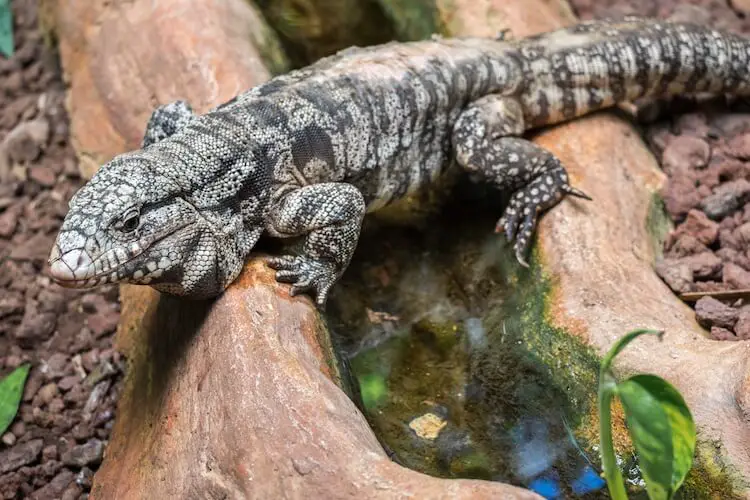
Tegus are a group of lizards that have a similar physical description, however, some are slightly smaller and can come in different color variations (e.g. red, black and white).
Argentine Tegus are native lizards to eastern and central South America. They are a product of convergent evolution and live in tropical rainforests, deserts and savannas.
Due to irresponsible owners freeing their captive lizards into the wild, some Black and White Tegus have been reported as far away as Florida.
The Argentine Black and White Tegu is very long, sometimes measuring 5 feet in length, and they have a robust, stocky build with long tails and powerful legs, giving them the ability to run very fast.
Their beaded skin is made up of black and white dots and stripes, however, their most unique feature is their “chubby cheeks”. This feature can only be seen in males and it is because of sexual selection (i.e. stronger jowls equate a stronger male).
This lizard is popular for two unfortunate reasons:
- They are a food delicacy
- They are used to make leather
However, there are many reasons why people love having this Giant Tegus as pets. They’re very attractive, smart, and calm. These lizards are one of the most affectionate reptile-species in captivity.
They establish a close bond with their owners, because of this, many Argentine Tegu owners compared owning one to owning a dog or cat, another reason why they’re so popular!
Mostly active during the day, they like to spend their time basking or looking for food, they are also known for having a calm and affectionate temperament making them great for handling.
| Summary Table | |
|---|---|
| Common Names | Argentine Giant Tegu, Black and White Tegu |
| Scientific Name | Salvator Merianae |
| Adult Size | Three to five feet long and 20 pounds |
| Lifespan | 15-20 years |
| Diet | Fruit, insects, and lean meat |
| Tank Size | Minimum of 8 by 4 by 4 feet |
| Humidity & Temperature | 75-85°F and humidity should be kept between 75-90% |
| Popular Alternatives | Red Tegu |
Argentine Tegu Care Guide
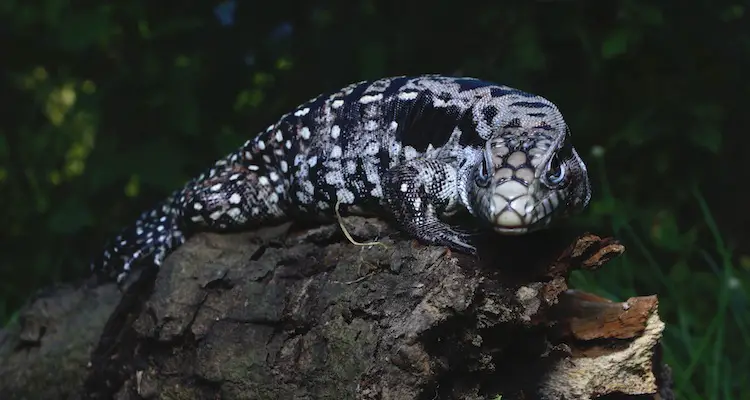
Outside of captivity, Argentine Tegus are found in the tropical areas of eastern and central South America. They are able to climb but prefer to stay closer to the ground (i.e. terrestrial) and may also be found swimming in freshwater.
Because the Argentine Tegu thrives in warm temperatures, in captivity they require an even-hotter basking spot (more on this below)!
Tank and Enclosure
Since they are very big lizards, they need a tank with enough room to fit their long tail. The best enclosures for Argentine Tegus are constructed out of melamine with one glass window in order to observe your pet.
Because of this lizard’s fast growth rate, and giant-adult size, it is okay to use an adult tank from the start however some owners choose to start with smaller cages:
- Hatchlings can be housed in 20-gallon terrariums.
- Juveniles can be housed in 80-gallon terrariums.
- As they grow, adults should live in a terrarium that is at least 8 x 4 x 4 feet.
Generally, females aren’t as long as males so their tank can be slightly smaller, but be sure to keep in mind that Tegus are active lizards and they should have a minimum cage size of 8 x 4 x 4 feet.
Lighting
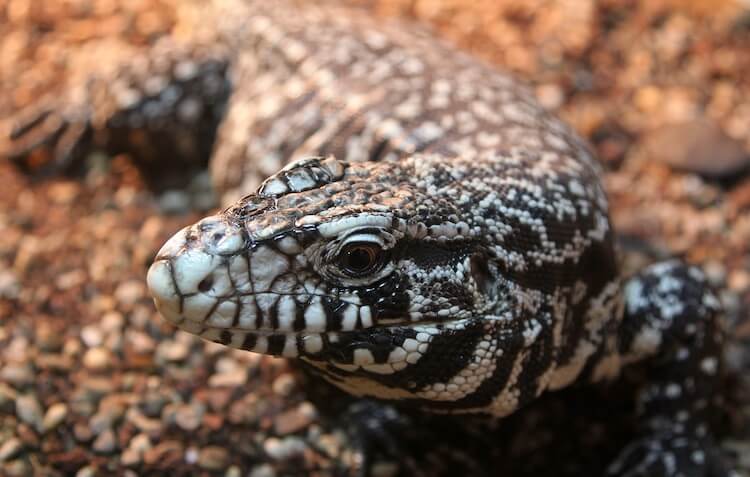
The Argentine Black and White Tegu requires UVB lighting to be healthy in captivity. Terrarium hoods that can support this type of lighting can be found very easily.
This type of Tegu also requires a very hot basking spot which can be achieved through red heat bulbs. A very hot basking spot of 100-110 degrees Fahrenheit should be available at all times. In the wild, Tegus spend a lot of time basking under the sun, so it is important to simulate this in their tank.
A correct enclosure should include a heat gradient. The basking spot should be the hottest area in the enclosure at 100-110 degrees Fahrenheit and the cooler-spot (on the opposite side) should stay between 75-80 degrees Fahrenheit.
Red bulbs, heat pads and ceramic heat emitters can all work to keep your tank nice and warm.
The correct humidity level is between 75-90%. This can be achieved by mixing water into the substrate until it is damp or with a spray bottle.
Substrate
Because Argentine Tegus love to burrow, they are going to have to live in lots of substrate.
Substrates made out of cypress mulch, coconut coir, sand or soil are the best because they will retain moisture which helps to keep the humidity high.
These reptiles love to burrow so hatchlings will need about a substrate depth of 4 inches and adults will need 8 inches. Substrates that are dusty or resinous should be avoided at all costs because they are toxic to Argentine Tegus.
They should also have a water dish big enough for them to climb into and soak. Any other decorations should be sturdy enough to support this lizard’s weight.
| Tank Tips | |
|---|---|
| Tank Type | Melamine |
| Lighting | UVB light and red-bulb for basking spot |
| Best Substrate | Cypress mulch or coconut coir |
Feeding An Argentine Tegu
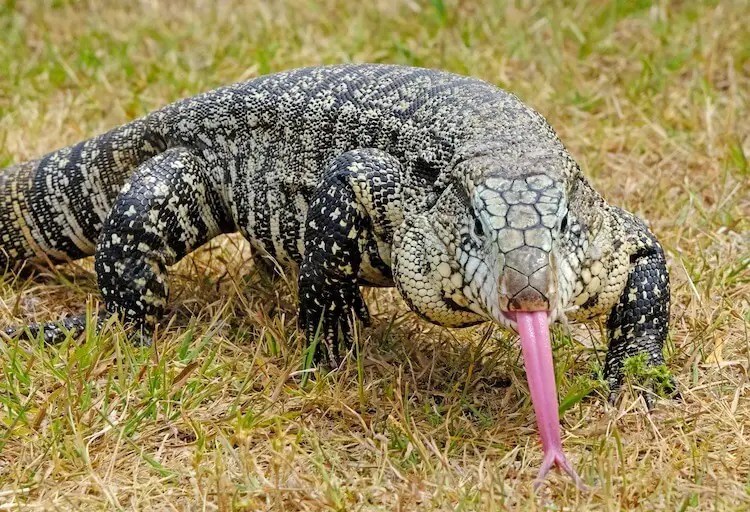
Like all reptiles, a healthy diet and a comfortable environment are key. Tegus can be considered opportunistic omnivores, meaning that they will eat whatever is available to them. In captivity a healthy diet should include: insects, fruit and meat. They are omnivores, making their diet easy to care for:
- Adults should be fed every three days
- Juveniles will need to eat every other day
- Younger hatchlings require being fed more frequently and will need to eat every day
For a balanced-diet, you should feed your lizard lean meats or other sources of protein such as egg or fish. They will also eat frozen rodents, fruit and vegetation. Baby Tegus can eat insects as long as they’re dusted in calcium powder.
Exclusive prey diets are not recommended for the Argentine Tegu because they might not obtain enough nutrients. They should be eating vegetation and fruit too. Left-over food should be removed after every meal.
Your Tegu’s tank should always have a dish of fresh and clean water. In addition to having a water dish, you may also want to provide a larger water container so your Tegu can soak in it. This will help prevent dehydration, aide in shedding and keep the proper humidity levels.
| Diet Summary | |
|---|---|
| Fruits | 30% of diet |
| Insects | 10% of diet |
| Lean meat | 60% of diet |
| Supplements Required | Calcium |
How To Keep Them Healthy
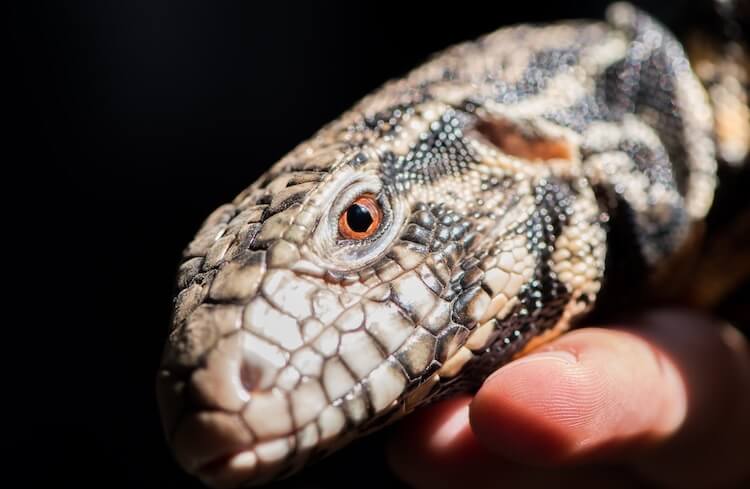
Tegus may harbor salmonella so you must wash your hands before and after handling.
Argentine Tegus have a reputation for being docile and calm. But like all lizards, they must get comfortable with you first before handling. If not, their flight-or-fight tendencies will kick in.
Adults will be more difficult in domesticating, so you should absolutely start handling these reptiles when they’re young. Hatchlings are also less likely to bite; they might try to run away instead.
They should be handled frequently so they can learn to trust you. Argentine Black and White Tegus tend to be food aggressive, so you should only try handling when there is no food in the cage.
You may stroke and pet them while they eat, but feeding them off of your hand is not recommended. Eventually you will find that your lizard will start coming to you instead of the other way around.
Bathing
Some lizards struggle to shed. However, the Argentine Tegu doesn’t need to bathe as the humidity levels in their tank should be enough for their skin to shed properly.
However, providing a tub of water large enough so your Tegu can soak won’t do any harm. If you do decide to do this, make sure you never leave it unattended and the water should not go past your Tegu’s shoulders.
Tank Cleaning
Faster spot-cleans should be undertaken daily. The enclosure should be misted a couple of times a day, either by hand or an automatic mister.
Their waste should be cleaned daily with your daily spot-cleaning.
Healthy waste is brown and is firm. It may be runnier if they just ate fruit. There may be a white or yellow substance that follows the stool which is made up of uric acid. If you notice that their stool is continuously runny, you should talk them to a vet for this may be a sign of internal parasites.
Deep cleaning the cage, food and water bowl(s) should be a monthly routine. You should use a 1:10 dilution of bleach as long as your Tegu isn’t inside the cage.
| Signs They Are Healthy | Sickness Symptoms |
|---|---|
| Clear eyes, nose and vent | Twitching (symptom of Metabolic Bone Disease) |
| Eats frequently | Loss of appetite |
| Active | Lethargy |
How Long Do Argentine Tegus Live?
In captivity, Argentine Black and White Tegus can live from 15 to 20 years.
The most common health concerns for this species is metabolic bone disease, calcium or phosphorous deficiency, salmonella and internal parasites. Most, if not all, of these health issues arise in the presence of an unhealthy diet or improper temperature and humidity levels.
In cooler months, you may notice your Tegu is very inactive and lethargic. This is completely normal! Because they come from hot climates, Argentine Tegus tend to brumate during the colder season.
Are Argentine Tegus Aggressive?
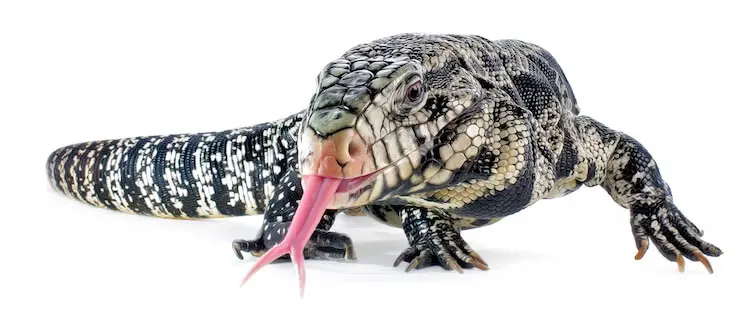
In the wild, these reptiles are found on the ground, either basking or looking for food to eat. They are mostly active during the day and are found alone. Wild Tegus are more aggressive than captives and will scare off predators by running on their hind feet or huffing.
Argentine Tegu is very hostile when it comes to their food and would most definitely engage in fights because of it.
They will communicate my making huffing noises if they’re irritated. If they arch their backs, this might mean that they are hostile and ready to attack.
In tanks, you may notice your lizard will nod their heads like Iguanas. They will spend most of their time in the basking spot and enjoy burrowing into their substrate and hiding.
If you let them out of the cage, they may seek out human attention and like to explore around.
Argentine Tegus are very friendly and intelligent, they are able to recognize their owners and make a connection with them. This is only true for lizards who have been handled since they were hatchlings.
Can Tegus Be Kept Together?
Argentine Tegus are able to share their living area. If you are keeping two or three, you will need a bigger cage with more hiding holes.
Just to be safe, make sure you are closely observing your lizards to avoid fighting, especially during feeding time.
Argentine Black and White Tegu Appearance
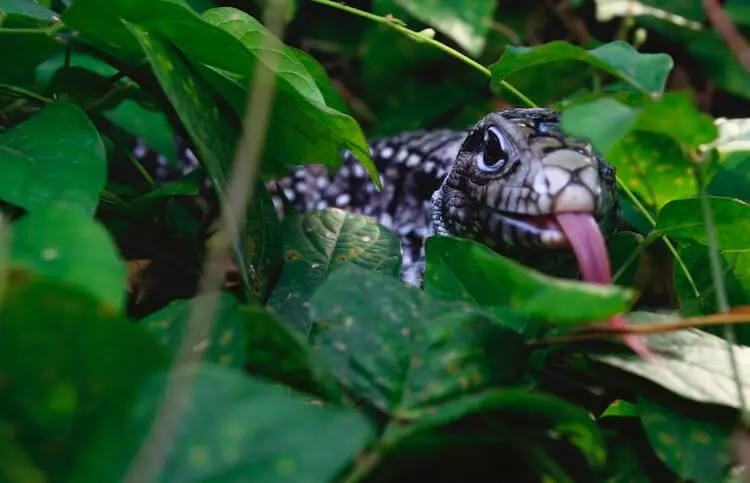
Differentiating between female and male Argentine Black and White Tegu is very easy. Females will be shorter than males (growing up to 3 feet) and males are typically 4.5 feet (1.5 feet longer):
- Male lizards can grow up to 4.5 feet long and weigh 20 pounds
- Females will be 3 feet and weigh about 15 pounds
Males also tend to have bigger jowls which gives them the appearance of “chubby cheeks”
As hatchlings, Argentine Tegus will be about 7-10 inches long. They tend to have a very fast growth rate, reaching about 75% of their final length in just 1 year.
The beaded skin of an Argentine Tegu will always be black and white. They will have many bands and stripes. As hatchlings, they might have green on their heads (reaching down to their necks); this color fades away within a few months and turns into black and white.
They can come in red, making them the Red Tegu. They are much like the Argentine but may be slightly smaller.
Baby Argentine Tegus
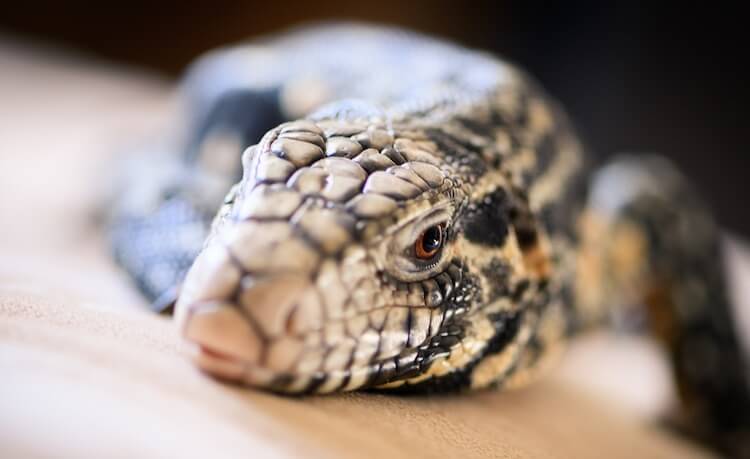
Argentine Tegus are sexually dimorphic, making it easy to distinguish male from female.
When trying to attract females, males will often make popping noises and shake their heads. Females may start swaying back and forth or drag the back of their bodies.
Copulation will take place for 1-2 weeks and eggs will hatch in about 58-60 days. Females can lay anywhere from 10 to 73 eggs in one clutch, though the average is 30.
The best incubation temperature is between 86-90 degrees Fahrenheit. Hotter temperatures may cause the babies to hatch ahead of time meaning they won’t be as healthy.
Hatchlings will need to be fed every day. They are mostly insectivorous and can be fed medium-sizde crickets, Dubia roaches, mealworms and earthworms. Hatchlings should be handled frequently at this point so they can grow up to be docile.
How Much Do Argentine Tegus Cost?
Argentine Tegus retail for about $200 USD. They can be found through many breeders, so it is important that you find a reputable breeder for a healthy lizard.
Care Guide Summary
Argentine Tegus may be a little intimidating to some amateur enthusiasts. If you are still unsure, but know you want to take on such a giant lizard, you can also look at the Red Tegu.
In order to successfully keep an Argentine Black and White Tegu, you must be able to give them a proper environment to live in. This means:
- Space (their enclosures are not small)
- Correct diet with lots of lean meat
- A tank that closely replicates their natural environment
Above all, your Tegu will need a lot of love. They are fantastic pets for people who seek companionship and are willing to put in the effort.
If you’re looking for a reptile that can provide you a rewarding relationship, you might have just come across your ideal pet. Argentine Tegus are one of the smartest, most affectionate reptiles out there.

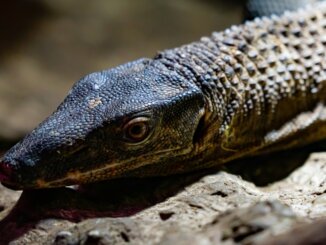
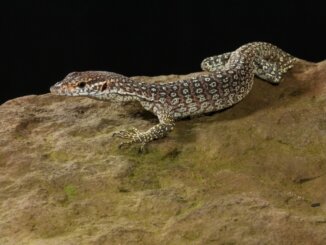
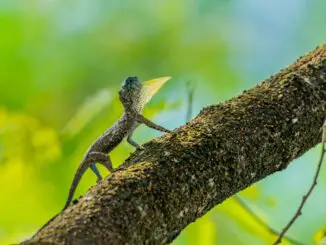

I’ve had my Tegu for at least a week and a half and He still haven’t ate. The previous owner fed him thawed small rats. I tried to feed him but he didn’t eat. I Also tried fruits, ground turkey and kale, even eggs. He licked the eggs drank a little water and that’s it. What am I doing wrong?
Hi Creyvonne, that’s a long time for a Tegu to not eat. Have you tried feeding fresh fish filets?
That really is a long time for a tegu to go without food. I recommend ‘braining’ the rats. Yes, I know it sounds gross, but is really helps. ‘Braining’ is when you cut open the top of the head of a rat or mouse, about 1/2″. The tegu will then smell the brain, and hopefully eat it. This has worked for all kinds of reptiles that eat mice and/or rats, and I think even with a few mammals who eat whole prey.
Try salmon mine like his food warm so I microwave it for 30 seconds
We have a Argentine blk/wht, can they eat most table food scraps? I read they like rice, does that have to be white rice only no salt? When should we start him on pinkies and roaches, he is about 15″ long.
Hi Anita, I would avoid table scraps and feeding rice. If you want to feet a treat then try fish filets!
I have a tegu I adopted three or so months ago, about a month into caring for him he stopped eating and started spending most of his time in his hide. Which I assumed meant that he was just starting to brumate ( I am in Northern Wisconsin and we are going into Fall currently). But instead of going down indefinitely he still seems to come out and bask and drink water etc. very early in the morning daily. Still refuses food more often than not, but seems otherwise healthy. Is this brumation or does he need help?
Hi Aaron,
What temperature is the tank? Before brumation he will be still be awake for short periods of time throughout the day. During this period it is best to offer food every three days. Once he really starts to slow down then withhold food.
We have had our tegu since June. He was great until a month ago when he stopped eating. He doesn’t seem to be losing weight and his skin looks healthy. My question is how long should we let him go without eating and sleeping all the time?
Hi Mike, this is known as brumation. It can last anywhere from three to six months for Tegus. We have a guide to bearded dragon brumation which, whilst not related to Tegus, will give you an overview.
Hi there. I own a Red Tegu and would like to know if I should use gloves to begin handling him. He has lived with us for 3 years.
Hi Heidi, yes, leather gloves are best. However taming is a long process and takes time.
I live in Naples Florida. It is not unusual to experience weeks of 92F all week long. Small Anole’s lizards, large bull frogs and toads were common. But then about four years ago I saw my first Monitor Lizard. The color was a combination of green and purple. Now going on five years these Monitor lizards rule the area. Some are are almost 2 feet in length. I have seen one eat a mid size tree frog. Is the Monitor an invasive species and are the top of the food chain?
Hi David, yes they are invasive in the Americas. Their natural range is Africa and Asia depending on their subspecies.
Hi I do female tegus require a different diet when pregnant?
Can you feed your tegu a salad of fruits, fish, chicken, eggs to keep it healthy and should I get male or a female
Our tegu hasn’t eaten in 2 weeks. He is a little over a ur old and all of a sudden he’s not really using his front legs. Any suggestions?
Get him to the vet Asap, as in right now.
Would salmonella be a concern from my Tegu walking on our carpet/laminated flooring?
Your tegu should be fine walking on the floor. Of course, it is recommended to clean the floors regularly, much as you would the enclosure.
I just want to say thank you Clint for putting up this website and having your YouTube videos. It is so refreshing to have a professional share knowledgeable information that is based om facts and science. I have 6 reptiles and learned a lot from you. Keep shining bright Clint!
how are tegus with dogs and/or cats in the house?
Tegus are clever animals with a complex personality. They can get adapted to both cats and dogs. They most likely won’t feel threatened by a cat, and you can find quite a few videos online of cats interacting with tegu lizards with a mix of curiosity and fear, while the Tegu quickly loses and fear (or interest) in the feline. Nonetheless, with dogs, that would most likely be curiously snooping around the lizard, their instincts might trigger a defensive state, especially with a big size difference, that can get your dog (or yourself) badly hurt. When making two animals meet, make sure they get used to each others’ smell before they actually meet, and do not restrain movement when they first make contact.